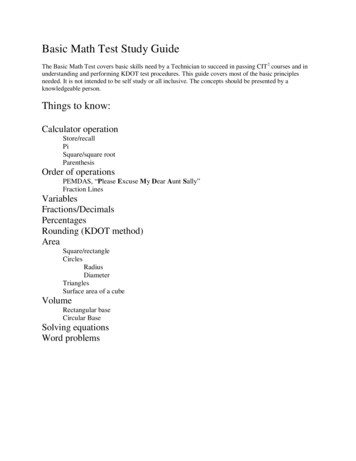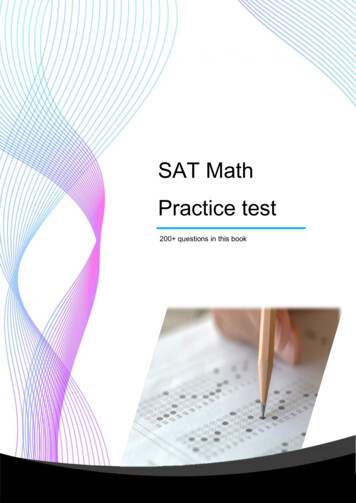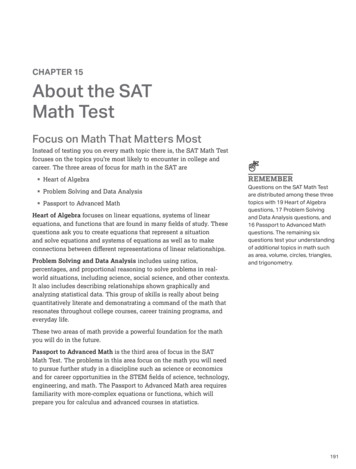
Transcription
Basic Math Test Study GuideThe Basic Math Test covers basic skills need by a Technician to succeed in passing CIT 2 courses and inunderstanding and performing KDOT test procedures. This guide covers most of the basic principlesneeded. It is not intended to be self study or all inclusive. The concepts should be presented by aknowledgeable person.Things to know:Calculator operationStore/recallPiSquare/square rootParenthesisOrder of operationsPEMDAS, “Please Excuse My Dear Aunt Sally”Fraction g (KDOT ianglesSurface area of a cubeVolumeRectangular baseCircular BaseSolving equationsWord problems
Order of operationsPEMDAS, “Please Excuse My Dear Aunt Sally”Mnemonic to remember:Going from left to right in an equation, operations insideParenthesis, such as (x y), are done firstExponents are done next. X*Y2.Multiplication; AB, AxB, A B orDivison operations; A/B or A B are done nextAddition, 2 X andSubtraction X-α are done lastFraction LinesOperations or groups of operations above and below the fraction line are completed separatelyand then the result above the line is divided by the result below the line. VariablesVariable: A letter or symbol used to represent a value that may change.Constant: A value that does not change which may be represented by a symbol. Pi for examplehas a value of approximately 3.14 and is represented by the symbol π.1.Solve the following for X 2X*2 X/2 X 5 3X X2 Solve the above if X 9
Variables2.Solve for X3*9 X2*5 1 X3X 9 3.Solve these problems if A 5 and C 3A 2C (A*C)/(C*A) 3A C*A (3A 7C)/C Solve for GG 4.α 1.253, z 2.056, A 5, Ya 10Solve:α z Ya-A α() (α*π)/Ya Answers1. For x 2, 4, 1, 7, 6, 4For x 9, 18, 4.5, 14, 27, 812. 27, 11, 33.11, 1, 30, 12, 2.5, 3.26674. 8.309, 5.152336, approx. 0.39
Fractions to DecimalTo convert a fraction to decimal, divide the number above the line (numerator) by the numberbelow the line (denominator). 0.3333, 0.3333, 1.8, 6, 0.0125PercentagesFractions can be changed to percentages by dividing the numerator by the denominator, the sameas changing to a decimal as shown above, and then multiplying the result by 100.For example 3/8 converted to a decimal is 3 divided by 8 or 0.375. Multiplying that result by 100gives us 37.5. 3 is 37.5% of 8.1. Convert the following to percentages:¼1/3½2/3Dividing a part of a group by the whole works the same way giving us a decimal that is thenmultiplied by 100 to give us a percentage in the same fashion as above.2. Out of 100 students, 27 voted to have orange juice for lunch. What percentage of studentswanted orange juice?3. 13 parts out of 1500 parts manufactured were found to be defective. What percentage of partswas defective? What percentage of parts is not defective?
PercentagesAnswers:1.25%33.33%50%66.67%2. 27%3. 0.87%, 99.13%Rounding, KDOT method (from 5.17.05)(1) Determine the last significant digit to be retained.(2) If the figure to the right of the last place to be retained is less than 5, retain the last place as itis.(3) If the figure to the right of the last place to be retained is greater than 5, increase the last placeby 1.(4) If the figure to the right of the last place to be retained is exactly 5, retain the last place as it isif it is an even number or increase the last place by 1, if it is an odd number.(5) Examples: The following table indicates correct rounding-off procedures.Observed orCalculated ValueRounded toRounded Off ValueSpecifiedLimitConform with aSpecified Value56.456.556.61%56565757% min.nonoyes0.540.550.560.1 %0.50.60.60.5% max.yesnonoThe rounded-off value should be obtained in one step by direct rounding off of the most precisevalue available and not in two or more successive roundings. For example, 89,490 rounded off tothe nearest 1000 is at once 89,000; it would be incorrect to round off first to the nearest 100,giving 89,500 and then to the nearest 1000 giving 90,000.Note that some test procedures require a different rounding procedure. KT-55 requires a valuebe calculated to 0.1 and rounded to the next higher whole number if the calculated value was nota whole number.
1. Round to the whole number using standard KDOT rounding.1.8751.523.49998725.012. Round the values stated in 1. using the method stated for KT-55 above1. 2, 2, 23, 252. 2, 2, 24, 25Surface areaArea of a RectangleThe surface area of a square or rectangle is determined by multiplying the length by the width. Inthe figure below we multiply 2.5 by 10 to get 25. Area is expressed in square units. This couldbe square inches (in2), square feet (ft2), square miles or whatever units are being used to measurewith. The units must be the same or converted to the same units.If the example below was 2.5 inches tall and 10 feet long we would convert the 10 feet to inchesby multiplying 10 (feet) by 12 (inches) to get 120 inches and then multiply that by 2.5 to get 300square inches.If the 2.5 was inches and the 10 was feet, we could change the 2.5 inches to feet by dividing 2.5by 12 for a result of approximately 0.2083 (feet) and then multiply by 10 (feet) getting an answerof 2.083 square feet (ft2).102.5Area of a CircleThe area of a circle is determined by multiplying the value of Pi (π) by the square of radius.2Written as area πr . Pi is approximately equal to 3.1416 and the value can be found on mostscientific calculators.
Surface areaArea of a CircleThe radius is the distance from the center point of a circle to any point on the circle or one halfthe diameter. In the figure below the radius is 3 feet so the area would be equal π*32 orapproximately 28.27 ft2.3 ftThe diameter of a circle is the length of a line through the center point and touching the edge ofthe circle on either side of the center point. In the example above the diameter would be 6 feet.If the diameter was given, as in the problem: “The diameter of a circle is 10 feet. What is the areaof the circle?” The diameter is divided by 2, that answer is squared and then multiplied by π. As2in the equation:* or 78.54 ft2.Area of a TriangleThe area of a triangle is determined by multiplying ½ times the length of the base times theheight. ½*b*h. Note the height is perpendicular to the base and may or may not equal the lengthof a side.The three triangles below all have the same area. 1/2 *7*8 or 28.887877Surface area of a cubeAll three dimensional objects such as a sphere, cube or a particle of sand have a property knownas surface area. The surface of a cube is composed of 6 sides that rectangular in shape. Thesurface area of a cube is the sum of the area of all of the sides. The area of each side is thelength times the width as in the example at the beginning of this section. In a cube the length
and width and height are the same. So, a four foot cube would have an area on one side of 4x4 or16 ft2, the 16 ft2 times 6 sides would equal 96 ft 2. A four foot wide cube has a surface area of 96ft2.1. What is area of a 5 foot square?2. What is area of a rectangle that is 14 inches long by 9 inches high?3. What is area circle having a radius of 25 meters?4. What is area circle having a diameter of 25 meters?5. What is area of a triangle that has a base 24 inches long and is 18 inches high?6. What is area of a 5 foot square in square inches?7. What is area of a rectangle that is 14 inches long by 9 inches high in square feet?8. What is the surface area of an 8 inch cube?Answers1. 25 ft2 2. 126 in2 3. 1963.5 m2 4. 490.87 m2 5. 216 in2 6. 3600 in2 7. 0.875 ft2 8. 384 in2VolumeThe volume of an object with an equal base and top that are perpendicular to the sides such as acylinder or a box is equal to the area of the base times the height. Volume is expressed in cubicunits such as cubic feet (ft 3).Calculate the area of the rectangular or circular base as shown in the section on area thenmultiply by the height of the object to determine the volume.What is the volume of the two figures shown?Fig. 1Fig. 2Radius 6”4’12”3’12’
VolumeAnswers: Fig.1 144 ft 3, Fig. 2 1357.17 in3Calculate the volume of a cube measuring 6 inches on a side.Answer: 216 in3Calculate the volume of a cylinder having a diameter of 3 feet and a height of 20 feet.Answer: 141.37 ft3Solving equationsRemembering that what is done to one side of an equation must also be done to the other sidecan help solve some math problem.The equation 3x 12, is solved by dividing both sides by 3. 3x divided by 3 equals x and 12divided by 3 equals 4. Therefore, x 43x 12x 1x x 4Similarly we can multiply both sides of an equation.1/4*z 24*1/4*z 2*44/4*z 81*z 8z 8We can add or subtract if we do it to both sides of the equation.In the equation 3x 3 15 we can eliminate the 3 on the left side by subtracting 3 from both sides3x 3 153x 3-3 15-33x 0 123x 12, then solving as above by dividing each side by 3, x 4
We can square or take the square root of both sides of an equation.36 a2 26 2The square root of a2 equals a6 a 9)2 92)2 81The square of a square root equals the value itselfy 81Word problemsWe have already seen word problems in the examples above, like “What is area of a rectanglethat is 14 inches long by 9 inches high?” When a problem is given in words, it should be writteninto a mathematical form that can be solved, an equation. To solve the given problem we knowthat we are trying to find the area. Area is length times width, written as area L x W. Thelength given is 14” and the width is 9” so, area 14”x9”. 14 x 9 126 so the area 14”x 9” andarea 126 in2.We were given the problem “Calculate the volume of a cylinder having a diameter of 3 feet and aheight of 20 feet” in the Volume section above. We know the volume of a cylinder equalsπr2xheight. Writing out the problem mathematically we getVolume πr2xHWhere r the radius and H height and π the constant Pi, approximately 3.1416.Plugging in the given value for r we getVolume π32xHPlugging in the given value for H we getVolume π32x20Plugging in the given value for Pi we getVolume 3.1416x32x20
32 9, so we haveVolume 3.1416x9ft2 x20ftThen multiplying 3.1416x9x20 we get approximately 5.65 so and since volume is expressed incubic feet we haveVolume 5.65ft 3When given a word problem, write out the formula necessary to provide the answer then plug inthe given values then solve mathematically.
Basic Math Test Study Guide The Basic Math Test covers basic skills need by a Technician to succeed in passing CIT2 courses and in understanding and performing KDOT test procedures. This guide covers most of the basic principles needed. It is not intended to be self study or all inclusive. The concepts should be presented by a knowledgeable person.










